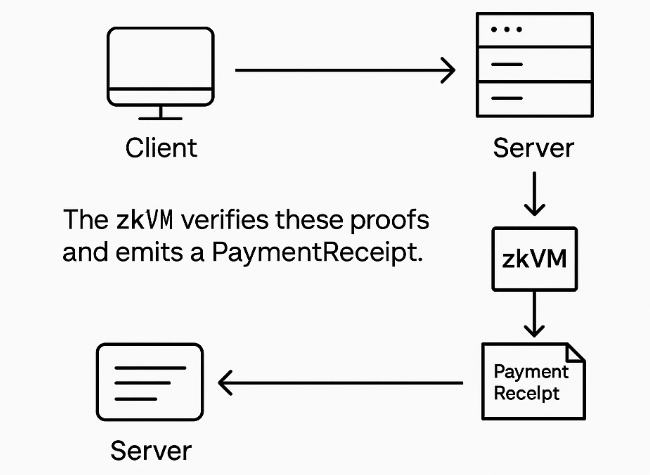.png)
x402 has recently become one of the most discussed ideas in crypto. It revives the long-dormant HTTP “402 Payment Required” status code, enabling micropayments to occur directly within web requests. The basic premise is simple: agents and applications can pay one another as easily as they exchange data.
But the potential impact of that simplicity has triggered a wave of attention. Projects across ecosystems are now announcing “x402 integrations”, eager to align with what many see as the next major evolution of web commerce - one that connects AI, APIs, and payments into a single programmable layer.
But most of these new announcements and integrations are superficial.
x402 alone does not create a functioning machine economy. It enables payment, not verification, attribution, or trust. Without supporting infrastructure - settlement, privacy, and verifiability - the concept breaks down the moment real agents begin to interact at scale.
But the @MetisL2, @GOATRollup, @LazAINetwork, and ZKM ecosystem is ready-made to handle not only the payment handshake, but also the attribution logic, cross-chain routing, and cryptographic verification that make it safe for autonomous agents to use.
Together, we form the first complete, production-ready ecosystem for delivering trust-minimized x402 at scale.
Each layer of the Metis–GOAT–LazAI–ZKM stack addresses a structural gap that must exist for machine-to-machine commerce to function optimally:

While others are merely adopting the x402 label, this ecosystem is implementing the real architecture that makes it viable in practice.
x402’s most critical limitation is trust. In its current form, each transaction depends on a facilitator - like the centralized Coinbase - to process and confirm payments. That model works for simple API billing, but not for agent economies, where hundreds of microtransactions can occur per second between autonomous participants.
ZKM replaces that facilitator with cryptographically verifiable computation.
Through Ziren, settlement logic runs inside a cryptographic execution environment that produces succinct proofs of correctness. These proofs show that each payment, attribution, and split occurred exactly as intended, without any intermediary attestation.

This turns ZKM into the proof engine of the x402 stack - the bridge between HTTP-level payments and blockchain-level verification.
Most current x402 integrations stop at enabling payment. The real challenge lies in creating a verifiable economic loop - one where money, data, and compute flow transparently between autonomous actors without introducing new intermediaries.
ZKM’s role ensures that this loop remains trust-minimized, cross-chain, and potentially even private:
Without this layer, x402 would replicate the same custodial patterns it was designed to escape. With it, the system becomes self-verifying.
Metis provides scale. GOAT connects to Bitcoin. LazAI defines attribution. ZKM ensures it can all be verified.
Together, we’re building the first operational model of x402 that can sustain real commerce between agents.
As attention continues to grow around x402, most ecosystems will replicate its headers. Only a few will replicate its trust model. The Metis–GOAT–LazAI–ZKM collaboration defines the latter - a full payment and proof infrastructure for the intelligent web.
x402 has recently become one of the most discussed ideas in crypto. It revives the long-dormant HTTP “402 Payment Required” status code, enabling micropayments to occur directly within web requests. The basic premise is simple: agents and applications can pay one another as easily as they exchange data.
But the potential impact of that simplicity has triggered a wave of attention. Projects across ecosystems are now announcing “x402 integrations”, eager to align with what many see as the next major evolution of web commerce - one that connects AI, APIs, and payments into a single programmable layer.
But most of these new announcements and integrations are superficial.
x402 alone does not create a functioning machine economy. It enables payment, not verification, attribution, or trust. Without supporting infrastructure - settlement, privacy, and verifiability - the concept breaks down the moment real agents begin to interact at scale.
But the @MetisL2, @GOATRollup, @LazAINetwork, and ZKM ecosystem is ready-made to handle not only the payment handshake, but also the attribution logic, cross-chain routing, and cryptographic verification that make it safe for autonomous agents to use.
Together, we form the first complete, production-ready ecosystem for delivering trust-minimized x402 at scale.
Each layer of the Metis–GOAT–LazAI–ZKM stack addresses a structural gap that must exist for machine-to-machine commerce to function optimally:

While others are merely adopting the x402 label, this ecosystem is implementing the real architecture that makes it viable in practice.
x402’s most critical limitation is trust. In its current form, each transaction depends on a facilitator - like the centralized Coinbase - to process and confirm payments. That model works for simple API billing, but not for agent economies, where hundreds of microtransactions can occur per second between autonomous participants.
ZKM replaces that facilitator with cryptographically verifiable computation.
Through Ziren, settlement logic runs inside a cryptographic execution environment that produces succinct proofs of correctness. These proofs show that each payment, attribution, and split occurred exactly as intended, without any intermediary attestation.

This turns ZKM into the proof engine of the x402 stack - the bridge between HTTP-level payments and blockchain-level verification.
Most current x402 integrations stop at enabling payment. The real challenge lies in creating a verifiable economic loop - one where money, data, and compute flow transparently between autonomous actors without introducing new intermediaries.
ZKM’s role ensures that this loop remains trust-minimized, cross-chain, and potentially even private:
Without this layer, x402 would replicate the same custodial patterns it was designed to escape. With it, the system becomes self-verifying.
Metis provides scale. GOAT connects to Bitcoin. LazAI defines attribution. ZKM ensures it can all be verified.
Together, we’re building the first operational model of x402 that can sustain real commerce between agents.
As attention continues to grow around x402, most ecosystems will replicate its headers. Only a few will replicate its trust model. The Metis–GOAT–LazAI–ZKM collaboration defines the latter - a full payment and proof infrastructure for the intelligent web.